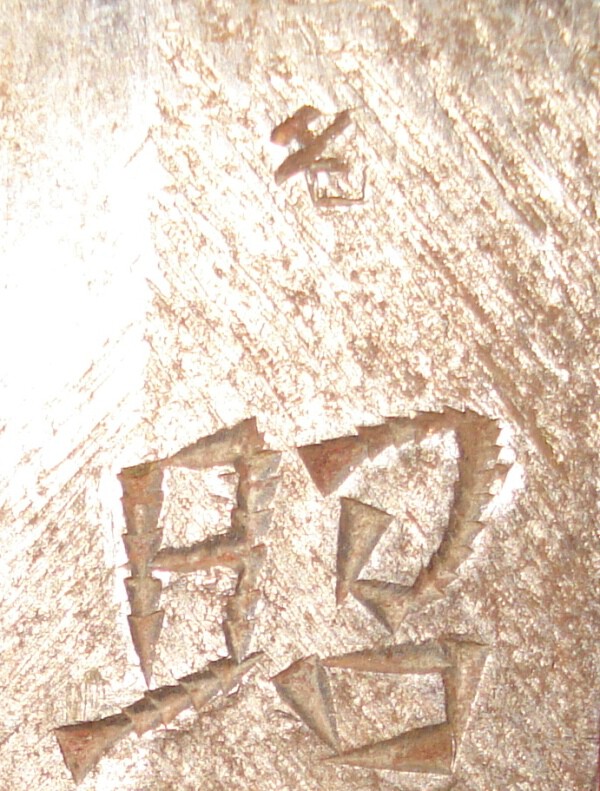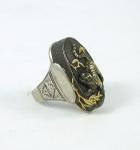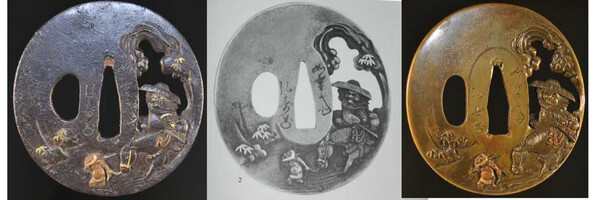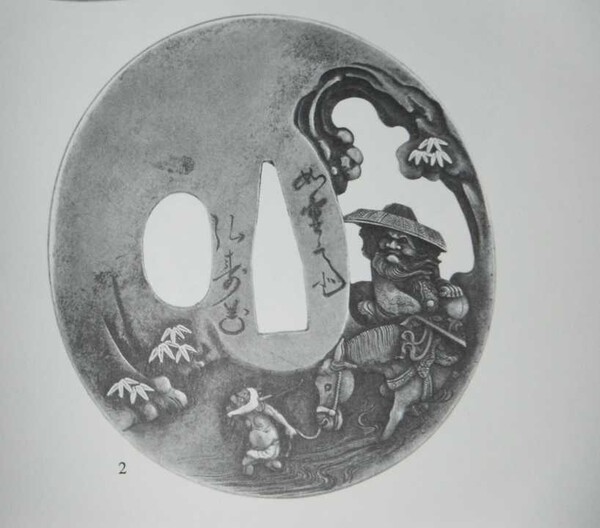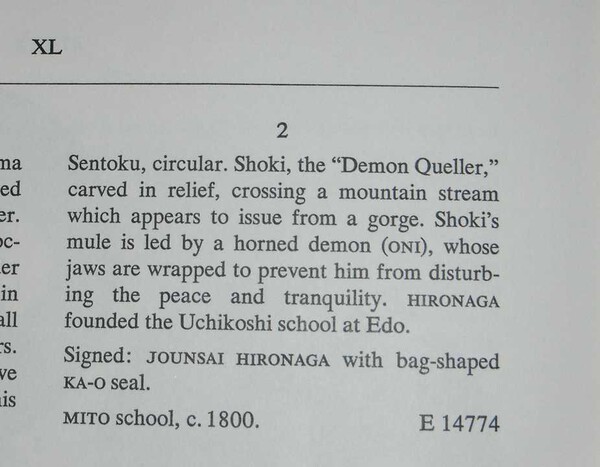-
Posts
435 -
Joined
-
Last visited
Everything posted by Lance
-
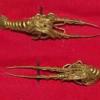
Gunto Sword Translation Please
Lance replied to hddennis's topic in General Nihonto Related Discussion
If you can get clear pictures of the blade showing the hamon at the same distance as the last pictures you took of the nakago that might help determining what you have. Regards, Lance -

Gunto Sword Translation Please
Lance replied to hddennis's topic in General Nihonto Related Discussion
Thanks, That is a great resource, I must have looked through those lists dozens of times and never even noticed it. Regards -

Gunto Sword Translation Please
Lance replied to hddennis's topic in General Nihonto Related Discussion
Interesting. Howard mentioned a Seki stamp, would this be considered traditionally made or more likely something similar to half forged? " (quoted from the thread below dealing with alternative steels ) viewtopic.php?f=50&t=15912&p=139958&hilit=half+forged#p139958 Regards, Lance -

Gunto Sword Translation Please
Lance replied to hddennis's topic in General Nihonto Related Discussion
Generally Seki stamp means Showato. Any dips or waves in the sword is probably due to the rushed war time polishes that many swords recieved: I don't remember where it was published, but I've seen old photos of assembly-line type setup with women doing the various steps in polishing as well as putting the mounts together. My understanding of a traditional Japanese polish is that if there was a flaw to remove,, they wouldn't just do one spot, they would subtly alter the whole blade to keep a proper geometry, especially on a new (at the time) sword when they'd be sure the outer skin was thick enough. The Kokuin is a puzzler, where did you find the information that it read forged 100 times? Most of these I've seen were a smith's name, if it was maybe Yoshi XX ? I'm really not sure about it, and would suggest posting images of the kokuin as a new topic; you'll have a better chance of getting a complete answer, Heck, I'd like to know as well! Regards, Lance -

Gunto Sword Translation Please
Lance replied to hddennis's topic in General Nihonto Related Discussion
I think it's just an acceptance stamp, by itself I don't think it points to a machine made blade or Gendaito. Below is a star stamped gendai with Nagaoya stamp. http://www.legacyswords.com/fs_ant_daito3.htm In your earlier posts you mentioned there not being any hamon, and fully hardened; if that's the case it wouldn't be a Gendai, and should be considered machine made or Showato Regards, Lance -

Gunto Sword Translation Please
Lance replied to hddennis's topic in General Nihonto Related Discussion
Looks like an incomplete or "half-stamp" for Nagoya arsenal. Sometimes when they applied the markings they didn't strike it fully, and you wouldn't get a complete impression. Below is a link to a post about arsenal stamps, lots of different examples to compare your's to if I'm incorrect. (also has other incomplete struck stamps, like Seki and Showa) viewtopic.php?f=50&t=8010&st=0&sk=t&sd=a&hilit=arsenal+stamps Regards, Lance -
Yes I've heard of Dai Token Ichi, I'm also familiar with key kantei points for Muramasa's hamon being a mirror image on both sides, and if suguha having koshiba (bump) at hamachi I've only handled one tanto and seen others at the Met in NY so I am certainly not an expert ,If you read all my posts I clearly stated that I wasn't qualified to state if they were genuine or which generation, just that price-wise I've seen swords by Ise--Muramasa school online in the past for between $5-10,000 sold by reputable dealers and auctions houses simply to dispel the notion that they all cost $50-100,000.... Unsigned, I think this was under $10,000 and from a much more reputabler seller http://www.nihonto.us/MURAMASA%20TANTO%20-%20NIDAI.htm The chances of finding a Muramasa on Ebay are pretty small but what are the chances of finding a sword by Hizen Iyo No Jo Munetsugu with an inscrription that it was a gift from a member of the Honda clan in 1730, the same year they were given control over the Tanaka Domain at a local community center where they hold a small militaria show 3 times a year, the rest of the time they host the Cub Scouts, have bake sales and bingo night I did so nothing's totally impossible.....(not adding this to try and get into any kind of contest I know I'd lose, just to illustrate that stranger things have happened) The other post was a tongue in cheek remark and question as to why it seems like ALL old papers for SWORDS from the 70's and 80's are deemed suspect, How many swords were sent to the NBTHK when kicho and tokubetsu kicho issued, this is especially relevant as I sometimes come into contact with these from older collections. (on a smaller scale as I'm a small timer) I also don't think developing an eye for quality or the finer points of judging fittings is any easier than swords, the same way you might have a Sengo school or Mino in that style with a signature added, you could find a Hamano piece with Shozui added. Judging Iron tsuba is an art unto itself The ability to recognize and appreciate different schools of tsubako and other fittings makers, even attributing them to a certain generation certainly deserves as much respect as kantei for blades by era and school, and smith, let alone recognizing a valid mei if signed. Lastly the question about the tanto with kicho papers is certainly valid even if only for the sake of discussion: Assuming the papers from 1963 are real and were issued for this tanto; what was the rationale for accepting ato-mei at the time? I'm not obsessing over it but Ido find it interesting and I'm genuinely curious why this was acceptable back then? Regards, Lance
-

Gunto Sword Translation Please
Lance replied to hddennis's topic in General Nihonto Related Discussion
At least with Seki and Showa stamps, if you're looking for a traditionally made blade you can just bypass them. That's one less headache Regards, Lance -

Gunto Sword Translation Please
Lance replied to hddennis's topic in General Nihonto Related Discussion
Hello Howard, My guess is either the Japanese site made a mistake or they wanted to associate it with a more unique/famous smith, or I'm wrong but I think the images I provided show well reasoned differences between the two. Traditionally even up to Showa and modern times times many smiths would use the first character from whoever taught them in their signatures, if not exact it would still be close. Also during the war there were mei cutters, who's job it was to put a signature on newly made swords. Seki in particular did this alot:. for example Fukumoto Amahide ran a sword factory and John Slough's Oshigata book mentions that 80 % of the swords signed by him were actually signed by his son, Fukumoto Kanemune and Ishido Hidetoshi, this could explain the slight variations. Something mentioned on this board alot whenever discussing signatures is they're never going to be be exactly the same, similar to your own signature, you probably couldn't take 2 of your own and get an exact match but you'd still be able to recognize your signature. Regards, Lance -

Gunto Sword Translation Please
Lance replied to hddennis's topic in General Nihonto Related Discussion
Your welcome, when I first acquired my sword I didn't even fully recognize the first character as "Kane" and kept thinking it was something else so you have me me beat. viewtopic.php?f=15&t=15779&hilit=+gendaito Now most of this is in my head so it's all a positive learning experience Regards, Lance -

Gunto Sword Translation Please
Lance replied to hddennis's topic in General Nihonto Related Discussion
Attached are some images to compare, starting with Kanetomo from John Slough's Oshigata Book, next are 2 Kanemune from Fuller and Gregory's Swordsmiths of Japan, (doesn't use Kiribuchi in mei, instead reads Gunsui, and the other mentions Gunma, between that and the shape of tang and mei I'm pretty sure it's him.) 2 Seki Kanemune from from Fuller and Gregory's book one Fukumoto Kanemune, Swordsmith Amahide had a son who used that name but the kanji I've usually seen for him is the Kane normally seen, so I don't know if it's his son or someone else, most likely there's some kind of connection though. Hope this is useful, Regards, Lance -

Shinto into Shinshinto - why?
Lance replied to Ken-Hawaii's topic in General Nihonto Related Discussion
Besides attracting new students, If the lords of the different provinces became aware of this new and improved way of making swords (by looking to the past) I'd assume they would probably want to learn more about them and have the same production abilities themselves, sending some of their own experienced /talented smiths. Would they need to serve a full apprenticeship or only spend a year or two before returning home? Then, if they taught their own students the same principals at home it could increase exponentially, one sword smith could produce 5 others through teaching, maybe more? Regards, Lance -

Gunto Sword Translation Please
Lance replied to hddennis's topic in General Nihonto Related Discussion
I think your sword and the other example are probably a Seki smith, instead of Kiribuchi Kanemune who was a student of Ryuminsai Kanetomo, who help develop Gunsuihagane. http://www.nihontocraft.com/Kanetomo.html From what I've seen any of the smiths who worked under him all used the same character for Kane that Kanetiomo did, http://www.sanmei.com/contents/media/A6 ... _PUP_E.htm I have a sword signed Kanetsugu using the same unusual character for 'Kane" as yours. it was suggested by another member as Seki, after doing some research I agree. Acouple images below of my blade and tang as well as another from the Japanese Sword index sword signed Seki Ju Kanemoto using the this similar 'Kane" Your sword looks to be out of polish, maybe having a small window opened will be able to identify itf there's any Hamon or hada before deciding if you wanted to have it polished, and if it was worth it.. Rgards, Lance -
Looks like my reading of the date must have been wrong, it appears that tokubetsu kicho pares stopped in 1982? http://www.nihontocraft.com/japanese_sword_papers.html I understand about the green papers and fittings, the financial motivations probably aren't as high, in part to there being a lot more fittings than swords available. I do have a question about the way that these older papers are perceived, is it only the examples in Japan? where it would be less complicated to resubmit; no overseas shipping, customs and agents to deal with? What about all the old time collections in the US, Europe, etc. with these papers? I understand that with the Internet creating more of an global market it's easier for items to travel from one place to another, and ultimately the blade or tosogu have to be judged on their own merits and not just a paper, but it seems like older papers outside of Japan in older collections are safer? Excuse me while I put on my tinfoil conspiracy hat : is there any validity to the idea that the old papers are inferior could be seen as a way to get a new stream of subnissions for "current" origami? I mean, except for the supposed branch office problems, most of the reference sources are already hundred(s) of years old, and many newer references were written by the same generation/group who may have been part of issuing these earlier papers? Kuniitro-san mentioned the second paper as having Okkake-mei or Ato-mei: so was this once acceptable and now it isn't? Regards, Lance
-
TheTokubetsu Kicho papers from the tanto that sold look to be from 1985 (the questionable period?) The other papers look to be Kicho from 1963, supposedly earlier papers are more trustworthy than later ones from the 80's? (looks to be a better made sword than the one that sold ,and appears to have the trademark bump in the hamon at hamachi, wether either are real Muramasa, and if so which generation is for better minds than me ) I do remember seeing an American dealer selling an unsigned tanto attributed to Muramasa a few years back for (I think) five or 6 thousand so $10,000 doesn't seem so unreasonably cheap that the price itself would raise suspicions, but it is the internet, everything's suspicious As (in)famous and highly regarded as Muramasa are, I've seen a few pop up on dealer sites or auction catalogs with more current papers for between $10-$20,0000, katana at the upper range. (It's times like those I wish I studied harder in school or had a wealthy relative ) Some much higher too, but which generation and workmanship of a particular sword is a big factor, similar to price ranges for different generations of Kanemoto. Below is a link to a good topic and article about Muramasa with mei examples that was created from the information posted, both are a great read. viewtopic.php?f=1&t=8879&hilit=articles+muramasa http://www.nihontomessageboard.com/arti ... amasa2.pdf Regards, Lance
-

Shinto into Shinshinto - why?
Lance replied to Ken-Hawaii's topic in General Nihonto Related Discussion
Great thread, the mention of Wazamono brought something to mind; I remember reading in various publications that many of the Koto masters were never realy tested as they were too valuable, and given what would amount to an "honorary Saijo O-wazamono ranking. I realize that they basically earned their esteem on the battlefield, but still interesting, and in part might explain why there's so many Shinto listed as mentioned earlier. links: http://japaneseswordindex.com/sharp.htm "None of the great Koto masters were tested. Among blades not tested were swords by Soshu Masamune, Soshu Sadamune, Bizen Nagamitsu and Ise Muramasa. Their swords were considered too valuable as historical art objects to risk damage by testing. Their swords have traditionally been considered among the finest blades ever made." http://www.jp-sword.com/files/wazamono/wazamono.html Regards, Lance -
For what it's worth, I don't see anything that points to a fake, except possibly the way the hole for the mekugi (peg hole) is on one side, but Ive seen such damage done when someone tried to remove a peg to see if their sword was signed. (true story, at a very small local gun show I was walking down one of the aisles and saw a two people take out a full sized hammer and a phillips head screw driver, to remove the peg, and they were pushing it out from the wrong side! This was around 15 years ago, I hope people know better now.) To me it looks like a real World War 2, made in 1930s-1940's unsigned machine made bade, basically Showato. Real , but no merit as an art sword, any value would be as a historic piece to a militaria collector or sentimental-heirloom value to a relative if brought home by a veteran. Polishing costs would probably cost 4 or 5 times what it would be worth even after restoration, and there wouldn't be any grain or hamon to bring out with a polish anyway, better off leaving it as is. If you're buying swords, Jean's link is a good/great way to go, especially if you're after a real antique historic/art sword. Regards, Lance
-
It's nice to know some of these were recoverable, over the years I've seen a few of what looked to have been pretty good fittings re purposed into various kinds of jewelry, and just assumed they were soldered in place or something similar. Regards, Lance
-
I'd agree with Mark, looks like they're the interiors of the little Meiji Era boxes used to hold pills, snuff, etc. Does this mean you were able to rescue some fittings from them? Below is a ring with a kashira that looks to have been part of a decent set: http://www.ebay.com/itm/ANTIQUE-JAPANES ... 5794wt_770 Regards, Lance
-
I think he's saying they aren't that good........I'd disagree and say they're decent mid level work (I like the top one more) and your assesment of $300-$350 a piece is correct, and would probably be what you'd see comparable tsuba sell for. Regards, Lance
-
That area was where the name of the owner or person submitting the sword was, it isn't that uncommon to see it removed or covered over. Regards, Lance
-
Since I posted the third example I'll stick my neck out, and say that if all three weren't made by the same person they were at least made by the same "group or studio" using the same methods of inlay and pattern book(? if that's the proper term) The way the lines/shapes are cut, and the flow of the water and cut-out for the cave as well as the expression on the horse's face are a few things that look very similar to me. I don't know if I would be qualified to say exactly what level of quality these display but none of them look to be made as if one was a "copy" of the others. (I do know I'd be happy to have any one of them.) Regards, Lance
-
The mei looks to read Jounsai Hironaga with Kao. (I have to admit I wasn't able to tranlate/read it) but the design looked familliar, and found a nearly identical tsuba with the same mei in the Peabody Museum of Salem) Attached are the images towards the back of the catalog. Regards, Lance
-
Found other examples of your stamps in the topic below, both look to refer to construction method used (seems unusual to have both on the same nakago?) viewtopic.php?f=50&t=8010&st=0&sk=t&sd=a&start=135 viewtopic.php?f=50&t=8010&st=0&sk=t&sd=a&start=75 Hopefully somebody will do a better job than me helping with the signature, and most likely be corrected (very bad allergies today so don't hold it against me :? ) but I'm guessing Amahide kitae kore for the bottom 4 characters Regards, Lance
-

O-wakizashi/Ko-katana translation help please
Lance replied to obiwanknabbe's topic in Translation Assistance
Agreed about not altering the wakizashi for all the reasons stated, and to add: even though a hagiri is considered a fatal flaw it's still an xxx-hundred year old piece of history. Since you do smithing, maybe a more interesting exercise might be for you to recreate a "copy" of this sword; matching shape and hamon (and hada if you forge the steel itself as well) Would make for a nice display AND a good sales pitch if and when it came time to sell as a pair. Regards, Lance Regards, Lance



